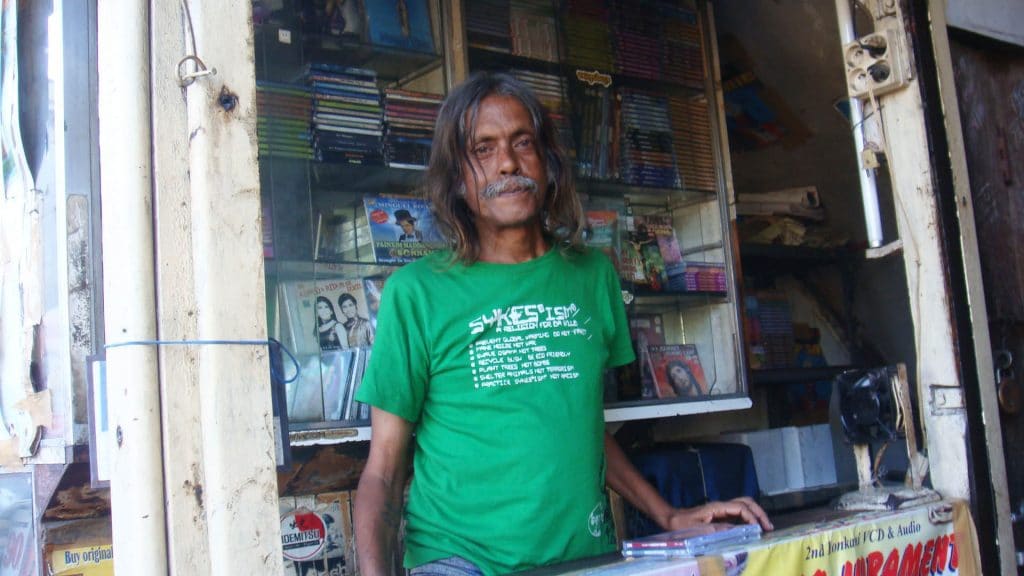Once upon a time in “Bombay,” the lunch homes hummed with filmy glitterati. But they don’t come here any more.
“I remember Guru Dutt as clear as crystal. If anyone asks for pirated film CD’s of Pyasa, Kagaz Ke Phool or Sahab, Biwi Aur Ghulam….I give them without charging any profit. Can you believe he called me Albert: by my first name?”
“On 11 October 1964, when he was found dead in his Pedder Road (Bombay) flat, I thought of crying loudly. But an invisible hand chocked my throat. Oh! Only a fortnight ago, I served him drinks and chakhna and got a “chowanni” (25 paise) as tips…. it was a big amount for me…..in those days.”
“Next very day, Mala Sinha and Raj Kapoor were to come to meet him at his flat. They did come, but at his funeral!” Albert recalls.
Where Memory Lingers
Mocambo Cafe traces its origin to early Bollywood Lunch Houses.Lunch homes, nostalgic Bombay bars and restaurants, mushroomed with the film-studios and theatres. As Bollywood turns 100 this year, the industry is celebrating. But there is mention of these lunch homes, which are also celebrating a century of sorts
Few outside Mumbai know about lunch homes. But the ideas of many great Hindi movies germinated in these lunch homes, the stomping grounds of the greatest film-wallahs.
They witnessed the Bollywood’s transformation: Golden Era (1950s and 1960s), Masala Movie era (1970s), the Hi-tech Era (1990s) and finally, Bollywood turned global.
Once upon a time in Bombay, “struggling” filmy-people stumbled in every evening and some even asked for “udhar” (credit) for their drinks and dinners….and owners obliged them. Munching “free” chakhna (salted peanuts) with drinks, they discussed for long hours about their film projects, love affairs and financial problems.
Albert was privy to it all.
Chakhna is no longer free at today’s lunch homes, a fact that Albert rues. What to do?
Time have changed. “Yeh Hai Bombay Meri Jaan ….” has now become Mumbai. But “Jayen To Jayen Kahan…..”? Albert hum this Talat Mehmood vintage if you ask him why he doesn’t leave Mumbai! For him, Mumbai is still Geeta Dutt’s rhythmic “Jaata Kahan Hai Diwane, Sab Kooch Yahan Hai Tera…..”
Albert Gomes, the Goanese “freedom fighter,” turned bar-waiter, turned seller of pirated film CD’s on Mumbai’s pavements, saw the film industry and lunch homes grow over the last 68-years. Fleeing the Portuguese police and spies, Albert came to “Bombay,” the Golden City to become its conqueror……as a bar waiter.
Mushrooming oi Lunch Homes
Bollywood lured creative people from all over India. They needed to develop contacts. Lunch homes were their contact-places.
Initially, few lunch homes dotted around Flora Fountain, Fort, Colaba, Marine Lines, Grant Road, Charnie Road, Mahalaxmi, Worli and Nagpada areas of South Mumbai. After 1940, they cropped up in large numbers in Bandra, Mahim, Santa Cruz, Matunga, Ville Parle, Chembur and Sion.
The growth of film-studios after 1928-29 greatly catalyzed lunch homes. The establishment of Ranjit Studios, Bombay Talkies, Minerva Movietone, Sagar Movietone, Paramount Studios, Central Studios, Jyoti Studios, Filmistan, Kamalistan, Mehboob Studio and R. K. Studios saw many lunch homes mushroom around them.
The birth of Edward Theatre, Imperial Cinema Hall, Royal Talkies, New Roshan Talkies, Nishat Cinema, Alfred Cinema Hall, Eros, Metro and Regal further boosted lunch homes as the movie-goers needed meals and drinks around movies.
As a large number of films in those days flopped at the box-office ending the careers of many, the struggling ones thronged at lunch homes to forge new contacts.
The Modern Lunch HomeWhen Ardeshir Irani produced India’s first talking and singing movie Alam Ara in 1931, Mumbai had an estimated 42 lunch homes. By 1947-48, they had tripled to nearly 148. The figure jumped to 285 in 1957 and again to 1,239 in 1979-80. Today, an estimated 3,685 lunch homes dot in Mumbai.
“Retired” 83-year-old Albert’s memory lingers with Bombay when the Goa liberation struggle was in full swing and he was an adolescent soldier in it. That was also the era when the Bollywood was re-defining itself.
Albert’s Tale
On one pitch-dark-moonless night in 1945, Albert fled from his birth place Comba (near Margao of Goa) as the Portuguese government pursued supporters of the legendary Goan freedom fighter Tristão de Bragança Cunha.
In those days, those fleeing from Goa or Daman and Diu had only place to go: Bombay. Cunha was arrested, thrown into a dark-dungeon at Fort Aguada in Goa, but Albert escaped to Bombay.
Arriving at the Victoria Terminus Railway Station, 15-year old Albert was totally confused. “Where to go? What to do for a living?” He thought about becoming a mazdoor in the port, the easiest to find job many Goans fleeing from Portuguese-ruled Goa turned to. But fate wanted him to serve drinks, soda-water and free Chakhna to the film-wallahs.
Wandering aimlessly, Albert visited a lunch home in the Fort area to eat. When he inquired about a job, the bar-owner did not charge for his meal and asked him to join as waiter, immediately. One of his waiters had eloped with the maid-servant of a Parsee household, so they were in desperate need for a replacement. That evening Albert donned a red coat and a white trouser — a waiter’s dress — and became waiter to the stars
